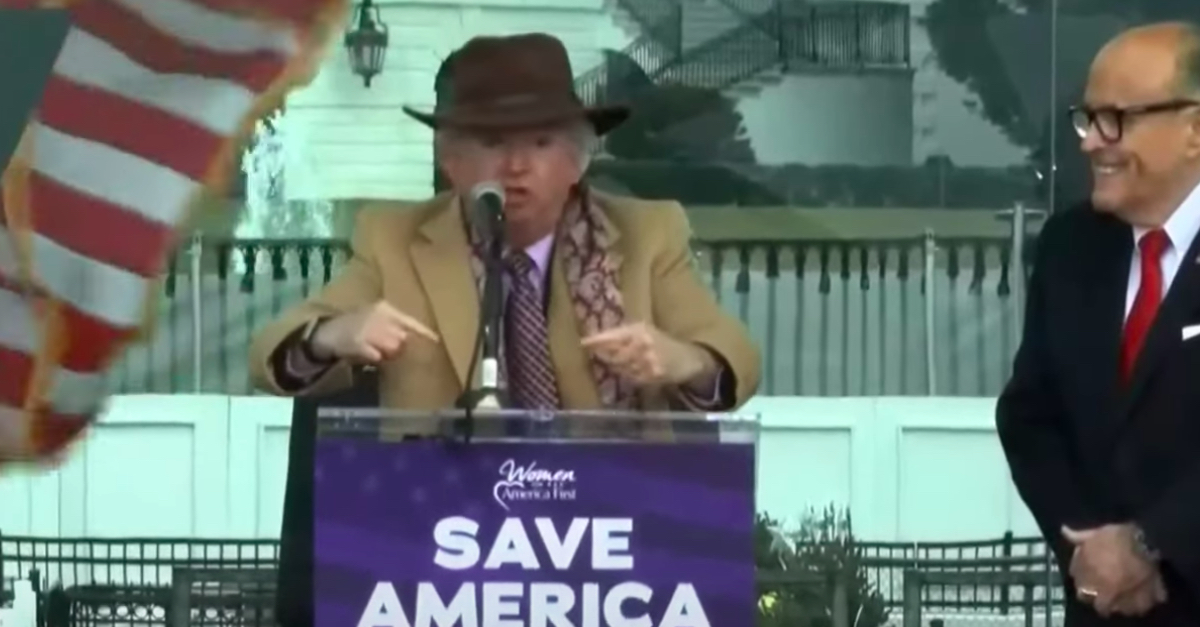
Former law professor John Eastman speaks at the pro-Trump “Stop the Steal” rally immediately before the Capitol was stormed.
The attorney whose six-part plan to block Congress’s certification of Joe Biden’s electoral victory has been branded the “coup memo” revealed in a legal brief late on Thursday that he spoke to then-President Donald Trump via “six conduits.”
Seeking to block the release of files to the Jan. 6 Committee, former Claremont Institute senior fellow John Eastman made the disclosure in a 48-page filing. His lawyers asserted attorney-client privilege over 72 documents consisting of communications “one or more of six conduits to or agents of the former President with whom Dr. Eastman dealt.”
“Three of the individuals had formal roles with former President Trump’s campaign committee, as evidenced by their @donaldtrump.com email addresses, and are also attorneys,” the brief continues. “The other three were members of former President Trump’s immediate staff, one of whom is also an attorney.”
Eastman sued Jan. 6th Committee Chair Bennie Thompson (D-Miss.) and others earlier this year, seeking to quash the panel’s subpoena seeking various records related to the assault on the U.S. Capitol. He previously lost an effort to keep the committee from obtaining more than 100 emails from his tenure as dean at Chapman University. In a scathing ruling, a federal judge awarded the vast majority of those communications to the committee, finding that the crime-fraud exception defeated his claims of privilege.
That was the ruling in which U.S. District Judge David O. Carter found that Trump “more likely than not” committed multiple federal crimes, including obstruction of an official proceeding and conspiracy to defraud the United States.
“Dr. Eastman and President Trump launched a campaign to overturn a democratic election, an action unprecedented in American history,” Carter wrote at the time. “Their campaign was not confined to the ivory tower—it was a coup in search of a legal theory.”
The March 28 order did not end proceedings over other privilege assertions, including over documents apparently handwritten by Trump.
“Twenty-one of the documents identified above are attachments to the email communications,” Eastman’s brief states. “Most are legal analysis memos (and their supporting data) or drafts of pleadings, quintessential privileged material (as well as work product). Two include hand-written notes from former President Trump about information that he thought might be useful for the anticipated litigation—again, quintessential privileged material. Six of the attachments are otherwise public documents, but as the California courts have recognized, ‘the privilege covers the transmission of documents which are available to the public, and not merely information in the sole possession of the attorney or client. In this regard, it is the actual fact of the transmission which merits protection, since discovery of the transmission of specific public documents might very well reveal the transmitter’s intended strategy.”
Trump isn’t the only client whose communications Eastman is trying to keep from the committee.
“Among the 601 documents still in dispute, Dr. Eastman has also asserted attorney-client privilege over fifty documents25 where the client (or potential client) was other than former President Trump or his campaign committee,” his lawyer Anthony T. Caso wrote.
Eastman says that some of the documents at issue involve communications with state legislators, who factor into the so-called “coup memo” as part of his theory that they had near-absolute discretion to certify electors of their choosing, whatever the vote totals.
“If State Legislatures have certified the Trump electors, he counts those, as required by Article II (the provision of the Electoral Count Act giving the default victory to the ‘executive’-certified slate therefore being unconstitutional). Any combination of states totaling 38 elector votes, and TRUMP WINS,” Eastman wrote in his memo, under a section subtitled “War Gaming the Alternatives.”
In the memo, Eastman acknowledged his plan was “BOLD, Certainly,” before falsely claiming the election was “Stolen” and he was “no longer playing by the Queensbury rules, therefore.”
Read Eastman’s latest legal brief below:
(Photo via YouTube)